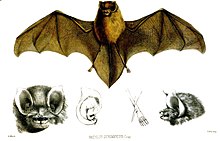Mexican funnel-eared bat
| Mexican funnel-eared bat | |
|---|---|

| |
| Scientific classification | |
| Kingdom: | Animalia |
| Phylum: | Chordata |
| Class: | Mammalia |
| Order: | Chiroptera |
| Family: | Natalidae |
| Genus: | Natalus |
| Species: | N. stramineus
|
| Binomial name | |
| Natalus stramineus Gray, 1838
| |
The Mexican funnel-eared bat (Natalus stramineus) is a bat species found in Central America and the Caribbean.[2]
Description[]
The Mexican funnel-eared bat has very distinct funnel shaped ears, hence its name. The ears tilt forward, and the face has a triangular shape and pale skin. Both sexes of this species are similar in size, unlike other species. They have brown fur, with it getting darker as it reaches the tip.[3] They tend to live in deep and very humid caves and have groups from 100 up to 10,000 bats.[4]
Distribution[]
They are found from Mexico through Central America, to Eastern Brazil, the Yucatan Peninsula, Honduras, Panama, and in the Caribbean in the Lesser Antilles, Hispaniola (Dominican Republic and Haiti), and Jamaica.[5]
Taxonomy[]
The related species Natalus espiritosantensis (formerly known as Natalus stramineus ssp. espiritosantensis)[6] is endemic to Brazil, and the subspecies Lesser Antillean funnel-eared bat (Natalus stramineus stramineus) is endemic to the Lesser Antilles islands.
References[]
- ^ Davalos, 1 L.; Tejedor, A. (2016). "Natalus stramineus". The IUCN Red List of Threatened Species. 2016: e.T14360A22040956. doi:10.2305/IUCN.UK.2016-3.RLTS.T14360A22040956.en.
- ^ Simmons, N.B. (2005). "Natalus stramineus". In Wilson, D.E.; Reeder, D.M (eds.). Mammal Species of the World: A Taxonomic and Geographic Reference (3rd ed.). Johns Hopkins University Press. p. 431. ISBN 978-0-8018-8221-0. OCLC 62265494.
- ^ Cervantes, 1 F. (2004). "New Records of Mammals from Hidalgo and Guerrero, Mexico". The Southwestern Naturalist. 49: 122–124. doi:10.1894/0038-4909(2004)049<0122:NROMFH>2.0.CO;2.
- ^ Arita, 1 HT. (1995). "NATURAL-HISTORY, INTERSPECIFIC ASSOCIATION, AND INCIDENCE OF THE CAVE BATS OF YUCATAN, MEXICO". The Southwestern Naturalist. 40: 29–37.
- ^ Reid, Fiona A. (2009). A field guide to the mammals of Central America & Southeast Mexico (2nd ed.). Oxford University Press. ISBN 978-0195343236.
- ^ Simmons, N.B. (2005). "Natalus espiritosantensis". In Wilson, D.E.; Reeder, D.M (eds.). Mammal Species of the World: A Taxonomic and Geographic Reference (3rd ed.). Johns Hopkins University Press. p. 431. ISBN 978-0-8018-8221-0. OCLC 62265494.
Further reading[]
- Ricardo López-Wilchis, Luis M. Guevara-Chumacero, Neófito ángeles Pérez, Javier Juste, Carlos IbáñEz, and Irene D. L. A. Barriga-Sosa. "Taxonomic Status Assessment of the Mexican Populations of Funnel-Eared Bats,Genus Natalus (Chiroptera: Natalidae)", Acta Chiropterologica 14(2), pp. 305-316, January 1, 2012, doi:10.3161/150811012X661639.
- Adrian Tejedor, "A New Species of Funnel-Eared Bat (Natalidae: Natalus) from Mexico", Journal of Mammalogy, Volume 86, Issue 6, 14 December 2005, pp. 1109–1120, doi:10.1644/1545-1542(2005)86[1109:ANSOFB]2.0.CO;2, JSTOR 4094534
- José Williams Torres-Flores and Ricardo López-Wilchis. "Trophic Niche and Diet of Natalus Mexicanus (Chiroptera: Natalidae) in a Tropical Dry Forest of Western Mexico", Acta Chiropterologica 20(2), pp. 343–350, February 14, 2019, doi:10.3161/15081109ACC2018.20.2.006.
External links[]
- IUCN Red List least concern species
- Bats of the Caribbean
- Least concern biota of North America
- Mammals described in 1838
- Mammals of Anguilla
- Mammals of Antigua and Barbuda
- Mammals of Dominica
- Mammals of Guadeloupe
- Mammals of Martinique
- Mammals of Montserrat
- Mammals of Saint Kitts and Nevis
- Natalus
- Taxa named by John Edward Gray
- Bat stubs
